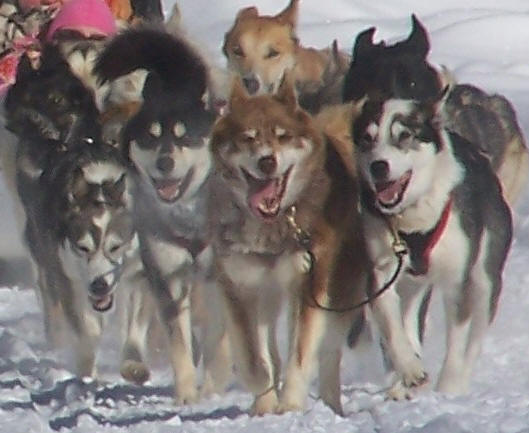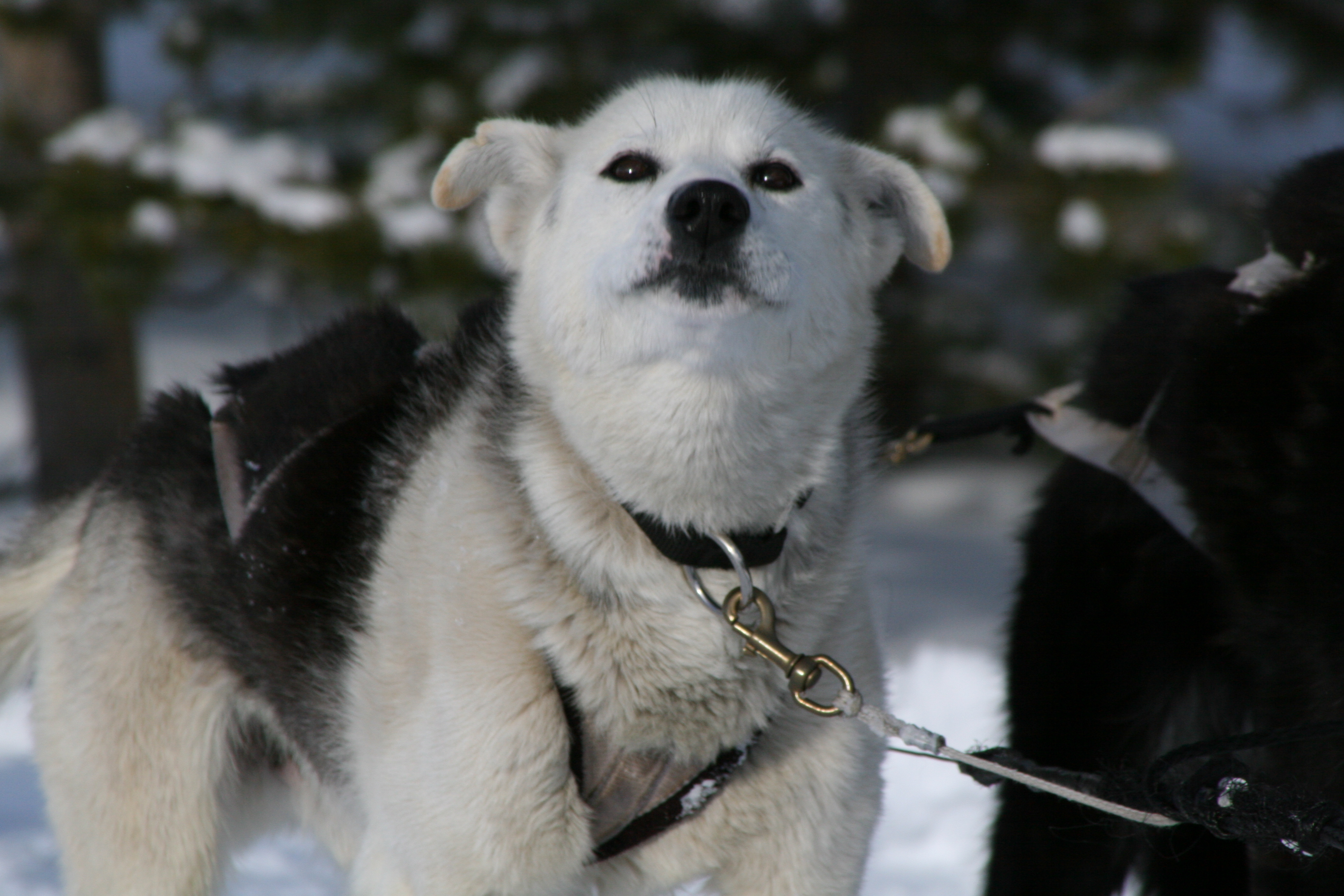|
About our Dogs
We use primarily Alaskan huskies on our
tours. Alaskan huskies are the descendents of the dogs that
pioneered the gold trails, freight runs, and mail routes of
the early Alaskan territory. In the early days, dog sleds were
the only means of wintertime transportation.
Dogs were in short supply and very valuable, so just about any
dog would do. As a result, cross breeding involving every large
breed from retrievers to pointers to Malamutes and Siberians
occurred. With the advent of snow machines and the decline of
the “working” sled dog the local Alaskan mushers turned to
recreation and racing and the focus of their breeding changed.
Unfortunately, the big, strong freight dogs could not compete
and a new breed began to appear. This new breed based primarily
on the smaller, faster “village” dogs became known simply as the
Alaskan Husky. Although not a “pure” breed the Alaskan Husky is
known for its speed, endurance, and gentle personality. The
Alaskan loves to run the way a retriever loves to retrieve.
We run five teams of 12 each and upon first
seeing 60 Alaskan huskies ready to run we usually get two
comments. The most common first timer comment is “they’ re
smaller than I thought they would be”. Our dogs average between
50 and 60 pounds and without the fluffy coat usually associated
with a Siberian Husky, they do appear smaller. The Alaskan is
considered to be the “marathoner” of the dog world and is the
dog used primarily in long distances races such as the 1175 mile
Iditarod Race Across Alaska. So, don’t be surprised by the lean
distance runner look of the Alaskan as opposed to the power
lifter look of the Malamute. Another comment we hear on a daily
basis is, “they all look different”. Because of the early
crossbreeding, the Alaskan has no standard color. However, if
color is ignored, most Alaskans have the same basic
conformation. They all have a long body for a longer stride
length and fairly long legs to match. They have a deep chest
that accounts for the tremendous endurance of the breed. They
all have the same basic “husky” shaped head with two possible
variables. Because of the crossbreeding, the Alaskan can have
either the typical husky “stand up” ears or the “flop” ears more
typical of a hound. Also, because of the Siberian husky in
their linage, the Alaskan can have brown eyes, blue eyes, or one
of each. re
smaller than I thought they would be”. Our dogs average between
50 and 60 pounds and without the fluffy coat usually associated
with a Siberian Husky, they do appear smaller. The Alaskan is
considered to be the “marathoner” of the dog world and is the
dog used primarily in long distances races such as the 1175 mile
Iditarod Race Across Alaska. So, don’t be surprised by the lean
distance runner look of the Alaskan as opposed to the power
lifter look of the Malamute. Another comment we hear on a daily
basis is, “they all look different”. Because of the early
crossbreeding, the Alaskan has no standard color. However, if
color is ignored, most Alaskans have the same basic
conformation. They all have a long body for a longer stride
length and fairly long legs to match. They have a deep chest
that accounts for the tremendous endurance of the breed. They
all have the same basic “husky” shaped head with two possible
variables. Because of the crossbreeding, the Alaskan can have
either the typical husky “stand up” ears or the “flop” ears more
typical of a hound. Also, because of the Siberian husky in
their linage, the Alaskan can have brown eyes, blue eyes, or one
of each.
Although we continually bring in proven
Iditarod finishers to constantly improve our kennel, we learned
years ago to not brag too much about pedigrees. Some of our
most beautiful, most highly pedigreed dogs can’t come close to
making our race team. Even though most of the rac e
team dogs are very social, they are very driven and focused and
can be a little intimidating if you don’t know them. More often
than not, our guests fall in love with the cute little mutt that
seems to have a smile on her face standing patiently waiting to
hear the “ok” and head off down the trail. So, we don’t put
much stock in pedigrees or “7th generation” dogs.
What’s more important to us is that the dog is happy and
healthy, loves its job, makes us happy, and makes our guests
happy. Now that’s a good dog! e
team dogs are very social, they are very driven and focused and
can be a little intimidating if you don’t know them. More often
than not, our guests fall in love with the cute little mutt that
seems to have a smile on her face standing patiently waiting to
hear the “ok” and head off down the trail. So, we don’t put
much stock in pedigrees or “7th generation” dogs.
What’s more important to us is that the dog is happy and
healthy, loves its job, makes us happy, and makes our guests
happy. Now that’s a good dog!
If you find your favorite and fall in love,
we do have an a doption
program. Just fill out an application and get your name and
the dogs name on the waiting list. If you can provide a good
home we will usually consider adoption. It’s always hard to
let them go, but we’d rather not wait until a dog retires and
then start trying to find a home for them. Of course, there are
a lot of them that we won’t ever let go and upon retirement
become our personal pets. doption
program. Just fill out an application and get your name and
the dogs name on the waiting list. If you can provide a good
home we will usually consider adoption. It’s always hard to
let them go, but we’d rather not wait until a dog retires and
then start trying to find a home for them. Of course, there are
a lot of them that we won’t ever let go and upon retirement
become our personal pets. |
